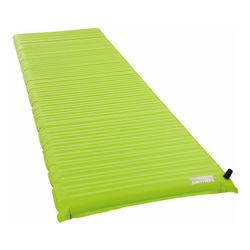Weight
As with any piece of kit, this is always the area where there has to be compromise. Naturally, the more insulation you pack into a sleeping mat, the heavier it's going to be.
It has to be a balance between what's comfortable for a good night's sleep and what's comfortable for carrying around with you in your bag. It's always a personal choice.
Packability
Basically, this is how small the mat rolls down. Some are little more than the size of a beer can - ideal for squeezing into your luggage or rucksack. Others take up more room and are akin to taking an extra jacket or two.
Be aware that the self-inflating variety is rarely as easy to repack to the size they were when you first got them!
Inflatables
Gone are the days when the only choice was a thin, closed-cell foam mat. Though still a budget option, the technology for inflatable mats has come far.
You can get a good insulated one that's only a tad heavier (sometimes lighter) than the non-inflatable variety, but much warmer and more packable.
There are usually three choices: self-inflating, which blows up by itself (usually has foam inside for warmth but is heavier); inflatable, where you do all the work yourself (lighter, smaller, often more expensive); and assisted inflatable, where valves and specially shaped openings and 'pumpbags' help fill the mat without the need to puff air into it yourself.
Insulation
Look for materials within the mat that reflect or capture the heat that your body will generate - this is key to keeping you warm.
Some have down or synthetic microfibres inside to help with this, others have foam that is shaped to trap hot air and keep you toasty. Many (though not all) have an 'R-value' to indicate how warm it will keep you.
The higher the number (between 3 and 5 would be at the upper end of the scale), the warmer it will be. Others simply have a minimum temperature rating or their own sliding scale.
Durability
Clearly, wherever inflatables are concerned, durability is key - you certainly don't want it to burst in the night. Look for strong, durable fabric such as tough polyester. Most come with repair kits, which are easy to use.
Also look for anti-slip coating, which helps to stop you slipping off the mat, or it from slipping down the tent (especially useful if camping on a slope).
Sizes
Mats will come in many different shapes and sizes. Typically these range from regular/standard to long (for the taller among us), with a choice of mummy (tapered), rectangular (non-tapered) and even women-specific (usually shorter and wider around the hips rather than the shoulders) designs. It's a case of picking what's right for you.
Discover more gear reviews to help you on your travels:








